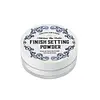What's inside
What's inside
 Key Ingredients
Key Ingredients

 Benefits
Benefits

 Concerns
Concerns

 Ingredients Side-by-side
Ingredients Side-by-side

Magnesium Potassium Fluorosilicate
AbrasiveSilica
AbrasiveMagnesium Myristate
Vinyl Dimethicone/Methicone Silsesquioxane Crosspolymer
Boron Nitride
AbsorbentCaprylic/Capric Triglyceride
MaskingTriethoxycaprylylsilane
Diphenylsiloxy Phenyl Trimethicone
Skin Conditioning1,2-Hexanediol
Skin ConditioningSynthetic Fluorphlogopite
CI 77492
Cosmetic ColorantEthylhexylglycerin
Skin ConditioningAscorbic Acid
AntioxidantMica
Cosmetic ColorantWater
Skin ConditioningCI 77491
Cosmetic ColorantDehydroacetic Acid
PreservativeAcrylates/Vp Copolymer
Methicone
EmollientPropanediol
SolventSodium Hyaluronate
HumectantHydrolyzed Hyaluronic Acid
HumectantTocopherol
AntioxidantSodium Hyaluronate Crosspolymer
HumectantHyaluronic Acid
HumectantSodium Acetylated Hyaluronate
HumectantMagnesium Potassium Fluorosilicate, Silica, Magnesium Myristate, Vinyl Dimethicone/Methicone Silsesquioxane Crosspolymer, Boron Nitride, Caprylic/Capric Triglyceride, Triethoxycaprylylsilane, Diphenylsiloxy Phenyl Trimethicone, 1,2-Hexanediol, Synthetic Fluorphlogopite, CI 77492, Ethylhexylglycerin, Ascorbic Acid, Mica, Water, CI 77491, Dehydroacetic Acid, Acrylates/Vp Copolymer, Methicone, Propanediol, Sodium Hyaluronate, Hydrolyzed Hyaluronic Acid, Tocopherol, Sodium Hyaluronate Crosspolymer, Hyaluronic Acid, Sodium Acetylated Hyaluronate
Silica
AbrasiveSynthetic Fluorphlogopite
Boron Nitride
AbsorbentAluminum Starch Octenylsuccinate
AbsorbentSqualane
EmollientTriethoxycaprylylsilane
1,2-Hexanediol
Skin ConditioningGlyceryl Caprylate
EmollientAvena Sativa Kernel Flour
AbrasiveCrambe Abyssinica Seed Oil
Skin ConditioningGlycerin
HumectantWater
Skin ConditioningEpilobium Fleischeri Extract
Skin ConditioningCitric Acid
BufferingPotassium Sorbate
PreservativeIngredients Explained
These ingredients are found in both products.
Ingredients higher up in an ingredient list are typically present in a larger amount.
1,2-Hexanediol is a synthetic liquid and another multi-functional powerhouse.
It is a:
- Humectant, drawing moisture into the skin
- Emollient, helping to soften skin
- Solvent, dispersing and stabilizing formulas
- Preservative booster, enhancing the antimicrobial activity of other preservatives
Boron Nitride is compound consisting of boron and nitrogen. It is used to absorb oil and modify adherence/ slip in products.
This means it is often used in makeup products to help them last longer.
Silica, also known as silicon dioxide, is a naturally occurring mineral. It is used as a fine, spherical, and porous powder in cosmetics.
Though it has exfoliant properties, the function of silica varies depending on the product.
The unique structure of silica enhances the spreadability and adds smoothness, making it a great texture enhancer.
It is also used as an active carrier, emulsifier, and mattifier due to its ability to absorb excess oil.
In some products, tiny microneedles called spicules are made from silica or hydrolyzed sponge. When you rub them in, they lightly polish away dead skin layers and enhance the penetration of active ingredients.
Learn more about SilicaSynthetic Fluorphlogopite is the synthethic version of mica. It consists of fluorine, aluminum and silicate.
Synthetic Fluorphlogopite is used to add volume to products.
It is considered non-irritating on the skin.
Learn more about Synthetic FluorphlogopiteTriethoxycaprylylsilane is a silicone used to bind and stabilize ingredients.
As an emulsifier, it helps prevent ingredients from separating. This can help elongate the shelf life of products.
Triethoxycaprylylsilane is often used to coat mineral sunscreens ingredients to help give a better feel. It also helps reduce oxidative stress in sunscreens.
Learn more about TriethoxycaprylylsilaneWater. It's the most common cosmetic ingredient of all. You'll usually see it at the top of ingredient lists, meaning that it makes up the largest part of the product.
So why is it so popular? Water most often acts as a solvent - this means that it helps dissolve other ingredients into the formulation.
You'll also recognize water as that liquid we all need to stay alive. If you see this, drink a glass of water. Stay hydrated!
Learn more about Water